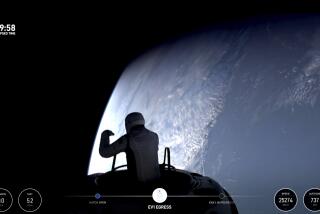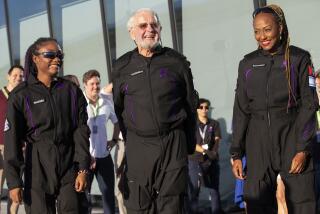At $4,000, this weight-loss plan has really taken off
- Share via
Science teacher Mike Hickey has long understood the difference between mass and weight. Now, floating in zero gravity above the Atlantic Ocean, he doesn’t just understand it; he feels it.
The 54-year-old Cleveland high school teacher is giggling like a middle-schooler with a crush: “Ha, ha, ha, ha, ha. I still have mass. No weight.”
Hickey, all 197 pounds of him, is drifting along with 38 other teachers inside a specially modified jet diving over the Atlantic Ocean.
After this, Hickey figures it will be simple to get his students to understand mass versus weight. The kids will see on video “this fat old man floating around like there was no weight there at all.... I definitely lost weight. I lost all my weight.”
Zero gravity, once an exclusive playground for astronauts and select scientists, is no longer out of reach to everyday people. Millionaires, doctors and teachers are feeling the fleeting freedom of weightlessness. The price is less than $4,000 for nearly five minutes in zero-G.
“It’s the wave of the future,” said Syracuse University public administration and space policy professor W. Henry Lambright. “It’s part of the maturity of the space program.”
In the more than 40 years of zero-gravity flights, beginning with astronauts, the world’s two largest space agencies have flown thousands of scientists, engineers, astronauts, and even the cast and crew of the movie “Apollo 13,” said Alan Ladwig, former NASA associate administrator. Ladwig, now Washington space operations chief for Northrop Grumman Corp., estimates that 50,000 people may have flown in zero gravity.
Five planes create zero-G conditions. NASA has one. The European Space Agency has one. The Russians have one. Two are commercially operated in the United States by Zero Gravity Corp. of Dania Beach, Fla.
Besides Zero Gravity Corp., there are at least three other companies that sell zero-G flights to tourists, including Novespace of France, Space Adventures Ltd. of Virginia and Incredible Adventures Inc. of Florida. Those companies must arrange for a jet either from Zero Gravity Corp. or the European or Russian space agencies.
In late September, French doctors took a patient in a European plane, operated by Novespace, and removed a cyst from his arm -- the first human surgery in zero gravity.
Last month NASA asked college students to apply for the chance to fly in zero and lunar gravity -- and do experiments -- on its specially equipped jet.
The planes soar to 32,000 feet and then plunge 8,000 feet so passengers can experience 25-second snippets of zero gravity during the descent. As the plane climbs, passengers experience 25 seconds of being pushed down hard as they feel 1.8 times the normal pull of the Earth.
NASA’s first zero-gravity jet, now retired, was dubbed the “vomit comet.” The newer commercial versions, geared more toward tourists, help passengers keep breakfasts down even as they float up. Those planes have about 35 seats in the rear for takeoff and landing and a padded play area in the middle where fliers float and frolic during weightless descent periods or lie pushed to the floor during super-gravity ascents.
In several flights that began in June, nearly 250 science teachers experienced weightlessness on Zero Gravity Corp.’s modified Boeing 727, which is usually aimed at private tourists willing to pay $3,750 a head for the experience. Their trips, complete with a boarding pass and Transportation Security Administration screenings, were paid for by aerospace company Northrop Grumman to encourage the teaching of science.
On Hickey’s two-hour, six-minute flight, out of Washington Dulles International Airport on an early autumn morning, the teachers felt Martian gravity (one-third of Earth’s) once, lunar gravity (one-sixth of Earth’s) four times, and zero gravity 11 times. Each of those gravity breaks produced bursts of laughter and applause, teachers bouncing off the plane’s walls and ceilings.
They tried quick science experiments, such as weighing items, juggling and playing with a Slinky.
“It was amazing, that was so amazing,” said Tracy Cindric, a high school science teacher from Gahanna, Ohio. Her flight experiment partner, Hickey, called the experience “an out-of-body thing.”
And that sensation is what people are looking for.
So far, about 3,000 tourists have paid to fly with Zero Gravity Corp., said chief executive officer Peter Diamandis. Eventually, he hopes to fly 10,000 people a year.
American University professor Howard McCurdy compared what’s happening in zero-G flights-- and even in space, where a handful of tourists have ventured -- to the American frontier of the 1790s when the first brave individuals established outposts after government explorers.
“It becomes safer and economically viable for individuals to go,” McCurdy said. “The difference is that we’re not going west, we’re going up.”
And down. The up-and-down ride can turn the stomachs of a few fliers, but flight planners go to great lengths to minimize motion sickness, said Zero Gravity’s chief marketing officer and preflight briefer, Noah McMahon. He said maybe three of the last 400 fliers threw up. On Hickey’s flight, one person did. Taking a recommended motion sickness prescription drug ahead of time and avoiding protein and dairy foods before flying seem to be a big advantage. The planes also ease tourists into zero gravity with the Martian and lunar experiences first. And the company reduced the number of up-and-down parabolas to about 15 because past experience shows people get sick between 20 and 30 repetitions, McMahon said.
This reporter was one of the few to feel slightly queasy and break into a sweat after the 12th plunge. Luckily, there was no need for the blue motion-sickness bag.
The overwhelming feeling, though, isn’t nausea, but a sense of freedom -- and disappointment over the fleeting period of weightlessness. About two or three seconds before each snippet of zero gravity was about to end, technical operations chief Matt Reyes would warn through his megaphone that everyone should point feet to the floor to avoid a headfirst landing.
“It happened so fast,” said math teacher Calley Connelly. Every time she heard Reyes give his warning, she wanted to shout back: “No, let’s stay up!”
While in the air, teachers float, bump into walls, the ceiling, floor and each other, giggling all the way, trying to eat candy and catch water droplets.
Nearly everyone played Superman, arms out in front, feet floating behind like the comic book character. Three teachers even put on red capes.
But trying to explain -- and teach -- what zero-G feels like leaves most people grasping for words. Connelly, who teaches at Howard High School in Maryland, figured it would be like a roller coaster, but it wasn’t.
“All of a sudden there was just a feeling that you can do anything -- you know, very strong,” she said.
Connelly’s difficulty in describing the experience is familiar to astronauts. Most struggle when asked how it feels, said former astronaut Jerry Linenger, who spent four months in zero gravity on the Russian space station Mir.
“We’ve been in gravity our whole lives. There is no vocabulary for weightlessness,” he said. “There’s no analogy, and it’s a subtlety. It’s pretty much indescribable.”
Diamandis, who has flown more than 40 times on his planes, put it this way: “How do you explain chocolate to someone who has never tasted it before?”
Explaining zero gravity was Hickey’s job when he returned from playing Superman above the Atlantic to the halls of a Cleveland high school. Watching him fall on his face -- “they think that’s hysterical,” Hickey said of his students. But more important, he said, the video offered “evidence that there is a bigger world out there for them.”
More to Read
Sign up for Essential California
The most important California stories and recommendations in your inbox every morning.
You may occasionally receive promotional content from the Los Angeles Times.













